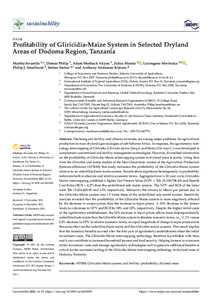| dc.contributor.author | Swamila, M. |
| dc.contributor.author | Philip, D. |
| dc.contributor.author | Akyoo, A.M. |
| dc.contributor.author | Manda, J. |
| dc.contributor.author | Mwinuka, L. |
| dc.contributor.author | Smethurst, P. |
| dc.contributor.author | Sieber, S. |
| dc.contributor.author | Kimaro, A.A. |
| dc.date.accessioned | 2022-05-23T13:42:45Z |
| dc.date.available | 2022-05-23T13:42:45Z |
| dc.date.issued | 2022 |
| dc.identifier.citation | Swamila, M., Philip, D., Akyoo, A.M., Manda, J., Mwinuka, L., Smethurst, P., ... & Kimaro, A.A. (2022). Profitability of Gliricidia-maize system in selected dryland areas of Dodoma region, Tanzania. Sustainability, 14(1), 1-13. |
| dc.identifier.issn | 2071-1050 |
| dc.identifier.uri | https://hdl.handle.net/20.500.12478/7477 |
| dc.description.abstract | Declining soil fertility and climatic extremes are among major problems for agricultural production in most dryland agro-ecologies of sub-Saharan Africa. In response, the agroforestry technology intercropping of Gliricidia (Gliricidia sepium (Jacq.)) and Maize (Zea mays L.) was developed to complement conventional soil fertility management technologies. However, diversified information on the profitability of Gliricidia-Maize intercropping system in dryland areas is scanty. Using data from the Gliricidia and maize models of the Next Generation version of the Agriculture Production Systems sIMulator (APSIM), this study estimates the profitability of the Gliricidia-Maize system relative to an unfertilized sole maize system. Results show significant heterogeneity in profitability indicators both in absolute and relative economic terms. Aggregated over a 20-year cycle, Gliricidia-Maize intercropping exhibited a higher Net Present Value (NPV = Tsh 19,238,798.43) and Benefit Cost Ratio (BCR = 4.27) than the unfertilized sole maize system. The NPV and BCR of the latter were Tsh 10,934,669.90 and 3.59, respectively. Moreover, the returns to labour per person day in the Gliricidia-Maize system was 1.5 times those of the unfertilized sole maize system. Sensitivity analysis revealed that the profitability of the Gliricidia-Maize system is more negatively affected by the decrease in output prices than the increase in input prices. A 30% decrease in the former leads to a decrease in NPV and BCR by 38% and 30%, respectively. Despite the higher initial costs of the agroforestry establishment, the 30% increase in input prices affects more disproportionally unfertilized sole maize than the Gliricidia-Maize system in absolute economic terms, i.e., 11.1% versus 8.8% decrease in NPV. In relative economic terms, an equal magnitude of change in input prices exerts the same effect on the unfertilized sole maize and the Gliricidia-maize systems. This result implies that the monetary benefits accrued after the first year of agroforestry establishment offset the initial investment costs. The Gliricidia-Maize intercropping technology therefore is profitable with time, and it can contribute to increased household income and food security. Helping farmers to overcome initial investment costs and manage agroforestry technologies well to generate additional benefits is critical for the successful scaling of the Gliricidia-Maize intercropping technology in dryland areas of Dodoma, Tanzania. |
| dc.description.sponsorship | United States Agency for International Development |
| dc.description.sponsorship | United States Department of Agriculture |
| dc.description.sponsorship | German Academic Exchange Service |
| dc.format.extent | 1-13 |
| dc.language.iso | en |
| dc.subject | Soil Fertility |
| dc.subject | Profitability |
| dc.subject | Gliricidia |
| dc.subject | Drylands |
| dc.subject | Maize |
| dc.title | Profitability of Gliricidia-maize system in selected dryland areas of Dodoma region, Tanzania |
| dc.type | Journal Article |
| cg.contributor.crp | Grain Legumes |
| cg.contributor.crp | Policies, Institutions and Markets |
| cg.contributor.affiliation | Sokoine University of Agriculture |
| cg.contributor.affiliation | International Institute of Tropical Agriculture |
| cg.contributor.affiliation | The University of Dodoma |
| cg.contributor.affiliation | Roskilde University |
| cg.contributor.affiliation | Commonwealth Scientific and Industrial Research Organisation |
| cg.contributor.affiliation | The Leibniz Centre for Agricultural Landscape Research |
| cg.contributor.affiliation | Humboldt-Universität zu Berlin |
| cg.contributor.affiliation | World Agroforestry |
| cg.coverage.region | Africa |
| cg.coverage.region | East Africa |
| cg.coverage.country | Tanzania |
| cg.coverage.hub | Eastern Africa Hub |
| cg.researchtheme | Social Science and Agribusiness |
| cg.identifier.bibtexciteid | SWAMILA:2022 |
| cg.isijournal | ISI Journal |
| cg.authorship.types | CGIAR and developing country institute |
| cg.iitasubject | Agronomy |
| cg.iitasubject | Climate Change |
| cg.iitasubject | Farming Systems |
| cg.iitasubject | Maize |
| cg.iitasubject | Plant Breeding |
| cg.iitasubject | Plant Production |
| cg.iitasubject | Soil Fertility |
| cg.journal | Sustainability |
| cg.notes | Open Access Journal; Published online: 21 Dec 2021 |
| cg.accessibilitystatus | Open Access |
| cg.reviewstatus | Peer Review |
| cg.usagerightslicense | Creative Commons Attribution 4.0 (CC BY 0.0) |
| cg.targetaudience | Scientists |
| cg.identifier.doi | https://dx.doi.org/10.3390/su14010053 |
| cg.iitaauthor.identifier | Julius Manda: 0000-0002-9599-5906 |
| cg.futureupdate.required | No |
| cg.identifier.issue | 1 |
| cg.identifier.volume | 14 |

